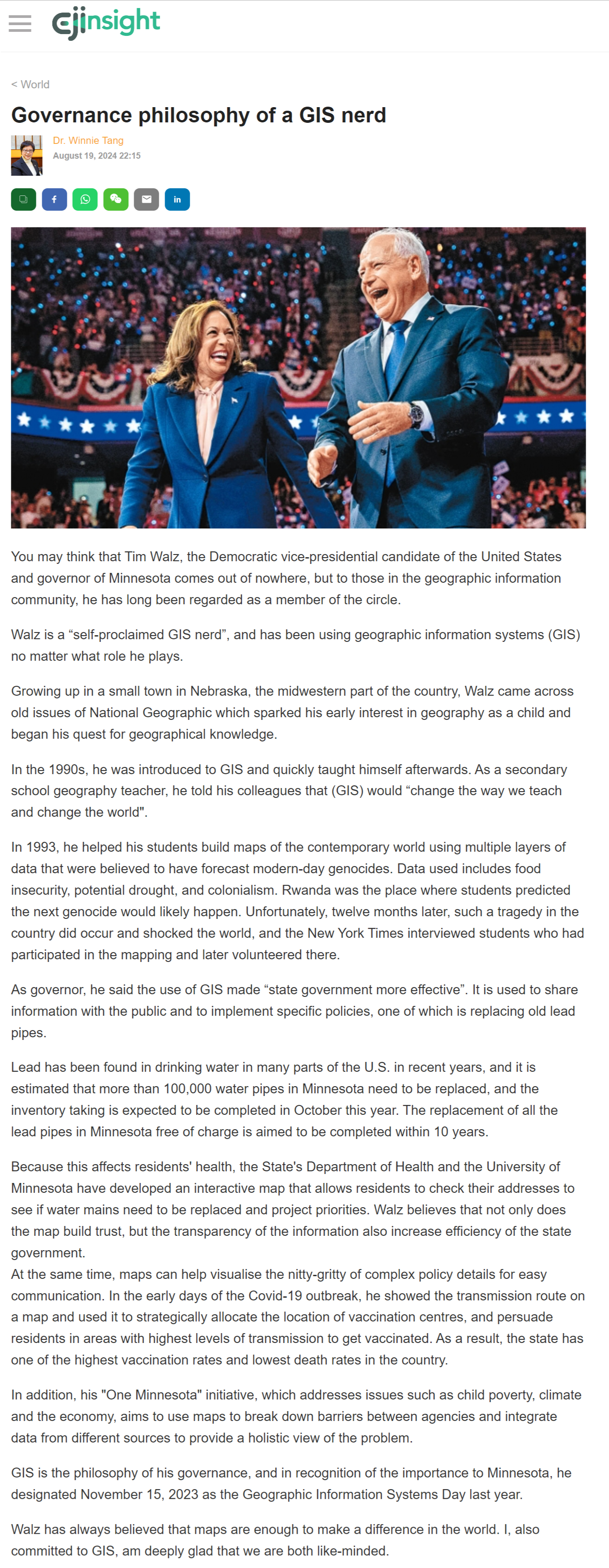網上版請按此

Governance philosophy of a GIS nerd
You may think that Tim Walz, the Democratic vice-presidential candidate of the United States and governor of Minnesota comes out of nowhere, but to those in the geographic information community, he has long been regarded as a member of the circle.
Walz is a "self-proclaimed GIS nerd", and has been using geographic information systems (GIS) no matter what role he plays.
Growing up in a small town in Nebraska, the midwestern part of the country, Walz came across old issues of National Geographic which sparked his early interest in geography as a child and began his quest for geographical knowledge.
In the 1990s, he was introduced to GIS and quickly taught himself afterwards. As a secondary school geography teacher, he told his colleagues that (GIS) would “change the way we teach and change the world".
In 1993, he helped his students build maps of the contemporary world using multiple layers of data that were believed to have forecast modern-day genocides. Data used includes food insecurity, potential drought, and colonialism. Rwanda was the place where students predicted the next genocide would likely happen. Unfortunately, twelve months later, such a tragedy in the country did occur and shocked the world, and the New York Times interviewed students who had participated in the mapping and later volunteered there.
As governor, he said the use of GIS made "state government more effective". It is used to share information with the public and to implement specific policies, one of which is replacing old lead pipes.
Lead has been found in drinking water in many parts of the U.S. in recent years, and it is estimated that more than 100,000 water pipes in Minnesota need to be replaced, and the inventory taking is expected to be completed in October this year. The replacement of all the lead pipes in Minnesota free of charge is aimed to be completed within 10 years.
Because this affects residents' health, the State's Department of Health and the University of Minnesota have developed an interactive map that allows residents to check their addresses to see if water mains need to be replaced and project priorities. Walz believes that not only does the map build trust, but the transparency of the information also increase efficiency of the state government.
At the same time, maps can help visualise the nitty-gritty of complex policy details for easy communication. In the early days of the Covid-19 outbreak, he showed the transmission route on a map and used it to strategically allocate the location of vaccination centres, and persuade residents in areas with highest levels of transmission to get vaccinated. As a result, the state has one of the highest vaccination rates and lowest death rates in the country.
In addition, his "One Minnesota" initiative, which addresses issues such as child poverty, climate and the economy, aims to use maps to break down barriers between agencies and integrate data from different sources to provide a holistic view of the problem.
GIS is the philosophy of his governance, and in recognition of the importance to Minnesota, he designated November 15, 2023 as the Geographic Information Systems Day last year.
Walz has always believed that maps are enough to make a difference in the world. I, also committed to GIS, am deeply glad that we are both like-minded.
Dr. Winnie Tang
Adjunct Professor, Department of Computer Science, Faculty of Engineering; Department of Geography, Faculty of Social Sciences; and Faculty of Architecture, The University of Hong Kong